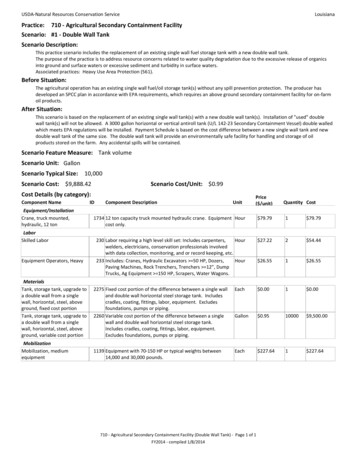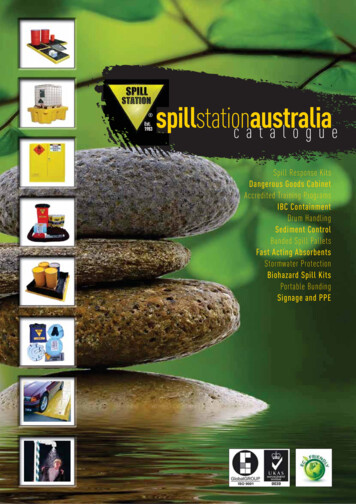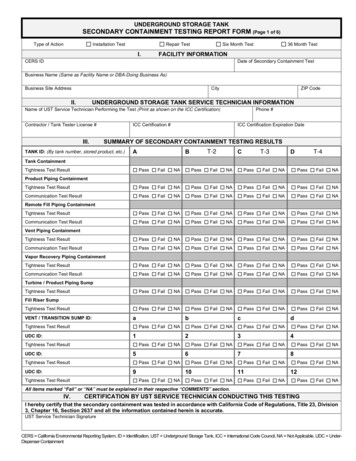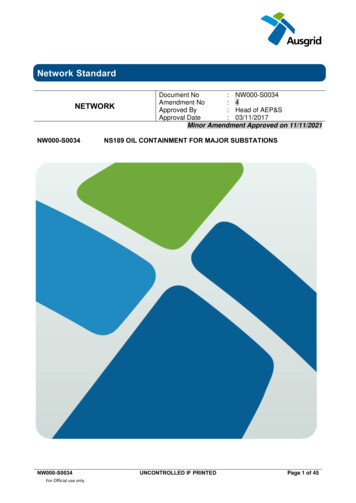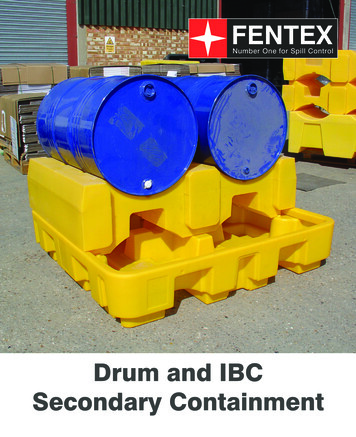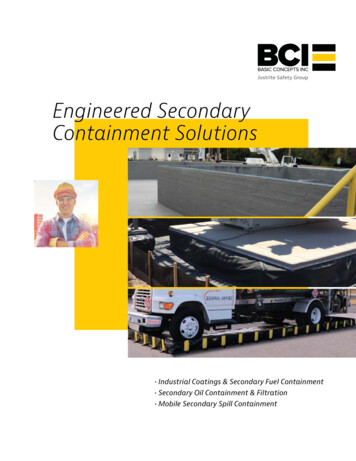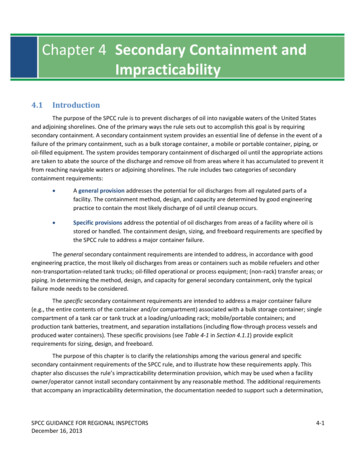
Transcription
Chapter 4 Secondary Containment andImpracticability4.1IntroductionThe purpose of the SPCC rule is to prevent discharges of oil into navigable waters of the United Statesand adjoining shorelines. One of the primary ways the rule sets out to accomplish this goal is by requiringsecondary containment. A secondary containment system provides an essential line of defense in the event of afailure of the primary containment, such as a bulk storage container, a mobile or portable container, piping, oroil-filled equipment. The system provides temporary containment of discharged oil until the appropriate actionsare taken to abate the source of the discharge and remove oil from areas where it has accumulated to prevent itfrom reaching navigable waters or adjoining shorelines. The rule includes two categories of secondarycontainment requirements: A general provision addresses the potential for oil discharges from all regulated parts of afacility. The containment method, design, and capacity are determined by good engineeringpractice to contain the most likely discharge of oil until cleanup occurs. Specific provisions address the potential of oil discharges from areas of a facility where oil isstored or handled. The containment design, sizing, and freeboard requirements are specified bythe SPCC rule to address a major container failure.The general secondary containment requirements are intended to address, in accordance with goodengineering practice, the most likely oil discharges from areas or containers such as mobile refuelers and othernon-transportation-related tank trucks; oil-filled operational or process equipment; (non-rack) transfer areas; orpiping. In determining the method, design, and capacity for general secondary containment, only the typicalfailure mode needs to be considered.The specific secondary containment requirements are intended to address a major container failure(e.g., the entire contents of the container and/or compartment) associated with a bulk storage container; singlecompartment of a tank car or tank truck at a loading/unloading rack; mobile/portable containers; andproduction tank batteries, treatment, and separation installations (including flow-through process vessels andproduced water containers). These specific provisions (see Table 4-1 in Section 4.1.1) provide explicitrequirements for sizing, design, and freeboard.The purpose of this chapter is to clarify the relationships among the various general and specificsecondary containment requirements of the SPCC rule, and to illustrate how these requirements apply. Thischapter also discusses the rule’s impracticability determination provision, which may be used when a facilityowner/operator cannot install secondary containment by any reasonable method. The additional requirementsthat accompany an impracticability determination, the documentation needed to support such a determination,SPCC GUIDANCE FOR REGIONAL INSPECTORSDecember 16, 20134-1
Chapter 4: Secondary Containment and Impracticability Determinationand the role of the EPA inspector in reviewing secondary containment requirements and impracticabilitydeterminations are also discussed.The remainder of this chapter is organized as follows. Section 4.2 provides an overview of the SPCC rule’s general secondary containment provisions,including exceptions to the requirement to provide secondary containment. Section 4.3 discusses the specific secondary containment requirements and the meaning of“sufficient freeboard.” Section 4.4 discusses issues related to secondary containment, such as active versus passivemeasures, the “sufficiently impervious” requirement, facility drainage, and man-madestructures. Section 4.5 describes the impracticability determination provision. Section 4.6 describes required measures when secondary containment is impracticable. Section 4.7 discusses how the impracticability determination may be used in certaincircumstances. Section 4.8 discusses alternative measures in the rule in lieu of secondary containment at oilproduction facilities.4.1.1 Overview of Secondary Containment ProvisionsThe SPCC rule includes several secondary containment provisions intended to address the variousactivities or locations at a facility where oil is handled. This section differentiates among these general andspecific secondary containment provisions.Table 4-1 lists all the secondary containment provisions of the SPCC rule for different types of facilities.SPCC GUIDANCE FOR REGIONAL INSPECTORSDecember 16, 20134-2
Chapter 4: Secondary Containment and Impracticability DeterminationTable 4-1:Secondary containment provisions in 40 CFR part 112.Type of FacilityAll FacilitiesOnshore StorageOnshore OilProductionSecondary ContainmentRule Section(s)General containment (areas with potential for discharge,such as piping–including flowlines, bulk storage containers,oil-filled operating and manufacturing equipment, and oilequipment associated with transfer areas)§112.7(c)Mobile refuelers and other non-transportation-related tanktrucks.§112.7(c)Loading/unloading racks**§112.7(h)(1)Qualified Oil-Filled Operational Equipment§112.7(c) or alternate measuresin §112.7(k)Bulk storage containers (except mobile refuelers and othernon-transportation-related tank trucks)§112.8(c)(2) or §112.12(c)(2)Mobile or portable oil containers (except mobile refuelersand other non-transportation-related tank trucks)§112.8(c)(11) or §112.12(c)(11)Bulk storage containers, including tank batteries,separation, and treating facility installations (except forflow-through process vessels and produced watercontainers)§112.9(c)(2)Flow-through process vessels§112.9(c)(2) or§112.7(c) and alternatemeasures in §112.9(c)(5)Flowlines and intra-facility gathering lines§112.7(c) or alternate measuresin §112.9(d)(3)Produced water containers§112.9(c)(2) or§112.7(c) and alternatemeasures in §112.9(c)(6)Onshore Oil Drillingand WorkoverMobile drilling or workover equipment§112.10(c)Offshore Oil Drilling,Production, andWorkoverOil drilling, production, or workover equipment§112.7(c)** Although this requirement applies to all facilities, loading/unloading racks are generally not present at typical oilproduction facilities or farms, as discussed in Section 4.7.3.Figure 4-1 through Figure 4-4 illustrate the relationships between the secondary containmentrequirements at various types of facilities. EPA inspectors should use the flowchart that corresponds to the typeof facility he or she is inspecting (see the figure description for each flowchart). The second row of eachflowchart identifies the types of containers, equipment, and activities or areas where oil is handled, withSPCC GUIDANCE FOR REGIONAL INSPECTORSDecember 16, 20134-3
Chapter 4: Secondary Containment and Impracticability Determinationreference to the appropriate secondary containment rule provision. The flowcharts note the use ofimpracticability determinations and additional design considerations for other areas with the potential fordischarge.Figure 4-1:Secondary containment provisions in 40 CFR part 112 related to onshore storage facilities(§§112.7 and 112.8 or 112.12).SPCC GUIDANCE FOR REGIONAL INSPECTORSDecember 16, 20134-4
Chapter 4: Secondary Containment and Impracticability DeterminationFigure 4-2:Secondary containment provisions in 40 CFR part 112 related to onshore oil production facilities(§§112.7 and 112.9).Oil production facilities do not typically have loading/unloading racks as defined in §112.2, but when oilis transferred through a loading/unloading rack, sized secondary containment in accordance with §112.7(h)(1)applies. Oil transfers to trucks within oil production facilities normally occur at transfer areas that are subject togeneral secondary containment in accordance with §112.7(c).SPCC GUIDANCE FOR REGIONAL INSPECTORSDecember 16, 20134-5
Chapter 4: Secondary Containment and Impracticability DeterminationFigure 4-3:Secondary containment provisions in 40 CFR part 112 related to onshore oil drilling andworkover facilities (§§112.7 and 112.10).SPCC GUIDANCE FOR REGIONAL INSPECTORSDecember 16, 20134-6
Chapter 4: Secondary Containment and Impracticability DeterminationFigure 4-4:Secondary containment provisions in 40 CFR part 112 related to offshore oil drilling, production,and workover facilities (§§112.7 and 112.11).79P4.2General Secondary Containment RequirementsAt a regulated facility, all areas and equipment with the potential for a discharge are subject to thegeneral secondary containment provision, §112.7(c). These may include bulk storage containers;mobile/portable containers; mobile refuelers and other non-transportation-related tank trucks; oil productiontank batteries, treatment, and separation installations; pieces of oil-filled operational or manufacturingequipment; loading/unloading areas (also referred to as transfer areas); and piping; and may include other areasof a facility where oil is present. For the areas where specific (sized) secondary containment is also required (asdescribed in Section 4.7), this sized secondary containment fulfills the general secondary containmentrequirements. The general secondary containment provision requires that these areas be designed withappropriate containment and/or diversionary structures to prevent a discharge in quantities that may beharmful (i.e., a discharge as described in §112.1(b)). “Appropriate containment” must be designed to addressthe most likely quantity of oil that would be discharged from the primary containment system (e.g., container,79Onshore components associated with offshore facilities may also be subject to §§112.8 or 112.9 requirements (as applicable).SPCC GUIDANCE FOR REGIONAL INSPECTORSDecember 16, 20134-7
Chapter 4: Secondary Containment and Impracticability Determinationequipment), such that the discharge will notescape secondary containment beforecleanup occurs. In determining the most likelyquantity, the facility owner/operator shouldconsider factors such as the typical failuremode (e.g., overfill, fracture in container wall,etc.), resulting oil flow rate, facility personnelresponse time, and the duration of thedischarge. An example calculation for atransfer area is included in Section 4.7.2. Asimilar calculation can be applied for any areaor equipment subject to the generalsecondary containment requirement (e.g., oilfilled equipment such as transformers).Calculations may be provided as part of thedocumentation to support the adequacy ofsecondary containment measures employedat the facility, although they are not required.Nevertheless, the Plan preparer must includeenough detail in the SPCC Plan to describe theefficacy of the measures used to comply withthe general secondary containmentrequirements in §112.7(c).§112.7(c)Provide appropriate containment and/or diversionary structuresor equipment to prevent a discharge as described in §112.1(b)except as provided in paragraph (k) of this section for qualified oilfilled operational equipment, and except as provided in§112.9(d)(3) for flowlines and intra-facility gathering lines at an oilproduction facility. The entire containment system, including wallsand floor, must be capable of containing oil and must beconstructed so that any discharge from a primary containmentsystem, such as a tank or pipe, will not escape the containmentsystem before cleanup occurs. In determining the method, design,and capacity for secondary containment, you need only to addressthe typical failure mode, and the most likely quantity of oil thatwould be discharged. Secondary containment may be either activeor passive in design. At a minimum, you must use one of thefollowing prevention systems or its equivalent:(1) For onshore facilities:(i)Dikes, berms, or retaining walls sufficiently impervious tocontain oil;(ii)Curbing or drip pans;(iii)Sumps and collection systems;(iv)Culverting, gutters, or other drainage systems;(v)Weirs, booms, or other barriers;(vi)Spill diversion ponds;(vii)Retention ponds; or(viii)Sorbent materials.Section 112.7(c) lists several methods(2) For offshore facilities:of providing secondary containment, which(i)Curbing or drip pans; orare described in Table 4-2. These methods are(ii)Sumps and collection systems.examples only; other containment methodsNote: The above text is an excerpt of the SPCC rule. Refer to 40 CFR part 112may be used, consistent with goodfor the full text of the rule.engineering practice. For example, a facilitycould use an oil/water separator, combinedwith a drainage system, to collect and retain discharges of oil within the facility. PE certification (or selfcertification, in the case of qualified facilities) of the SPCC Plan includes verification that the selected secondarycontainment methods for the facility are appropriate and follow good engineering practice.SPCC GUIDANCE FOR REGIONAL INSPECTORSDecember 16, 20134-8
Chapter 4: Secondary Containment and Impracticability DeterminationDischarge as described in §112.1(b) is a discharge in quantities that may be harmful, as described in part 110 of thischapter [40 CFR part 110], into or upon the navigable waters of the United States or adjoining shorelines, or into orupon the waters of the contiguous zone, or in connection with activities under the Outer Continental Shelf Lands Act orthe Deepwater Port Act of 1974, or that may affect natural resources belonging to, appertaining to, or under theexclusive management authority of the United States (including resources under the Magnuson Fishery Conservationand Management Act).Note: The above text is an excerpt of the SPCC rule. Refer to 40 CFR part 112 for the full text of the rule.Table 4-2:Example methods of secondary containment listed in §112.7(c).SecondaryContainment MethodDescription of ExamplesDikes, berms, orretaining wallssufficiently imperviousto contain oilTypes of permanent engineered barriers, such as raised earth embankments or concretecontainment walls, designed to hold oil. Normally used in areas with potential for largedischarges, such as single or multiple aboveground storage tanks and certain piping.Temporary dikes and berms may be constructed after a discharge is discovered as an activecontainment measure (or a countermeasure) so long as they can be implemented in time toprevent the spilled oil from reaching surface waters. Please see Section 4.4.1, Passive versusActive Measures of Secondary Containment.CurbingTypically consists of a permanent reinforced concrete or an asphalt apron surrounded by aconcrete curb. Can also be of a uniform, rectangular cross-section or combined withmountable curb sections to allow access to loading/unloading vehicles and materials handlingequipment. Can be used where only small spills are expected and also used to direct spills todrains or catchment areas. Temporary curbing may be constructed after a discharge isdiscovered as an active containment measure (or a countermeasure) so long as it can beimplemented in time to prevent the spilled oil from reaching surface waters. Please seeSection 4.4.1, Passive versus Active Measures of Secondary Containment.Culverting, gutters, orother drainage systemsTypes of permanent drainage systems designed to direct spills to remote containment ortreatment areas. Ideal for situations where spill containment structures cannot or should notbe located immediately adjacent to the potential spill source.WeirsDam-like structures with a notch through which oil may flow to be collected. Generally usedin combination with skimmers to remove oil from the surface of water.BoomsForm a continuous barrier placed as a precautionary measure to contain/collect oil. Typicallyused for the containment, exclusion, or deflection of oil floating on water, and is usuallyassociated with an oil spill contingency or facility response plan to address oil spills that havereached surface waters. Beach booms are designed to work in shallow or tidal areas.Sorbent-filled booms can be used for land-based spills. There are very limited applications foruse of booms for land-based containment of discharged oil.BarriersSpill mats, storm drain covers, and dams used to block or prevent the flow of oil. Temporarybarriers may be put in place prior to a discharge or after a discharge is discovered. These areall considered effective active containment measures (or countermeasures) as long as theycan be implemented in time to prevent the spilled oil from reaching navigable waters andadjoining shorelines. Please see Section 4.4.1, Passive versus Active Measures of SecondaryContainment.SPCC GUIDANCE FOR REGIONAL INSPECTORSDecember 16, 20134-9
Chapter 4: Secondary Containment and Impracticability DeterminationSecondaryContainment MethodDescription of ExamplesSpill diversion pondsand retention pondsDesigned for long-term or permanent containment of storm water, but also capable ofcapturing and holding oil or runoff and preventing it from entering surface water bodies.Temporary spill diversion ponds and retention ponds may be constructed after a discharge isdiscovered as an active containment measure (or countermeasure) as long as they can beimplemented in time to prevent the spilled oil from reaching navigable waters and adjoiningshorelines. There are very limited applications for use of temporary spill diversion andretention ponds for land-based containment of discharged oil due to the timely availability ofthe appropriate excavation equipment required to rapidly construct the ponds. Please seeSection 4.4.1, Passive versus Active Measures of Secondary Containment.Sorbent materialsInsoluble materials or mixtures of materials (packaged in forms such as spill pads, pillows,socks, and mats) used to recover liquids through the mechanisms of absorption, adsorption,or both. Materials include clay, vermiculite, diatomaceous earth, and man-made materials.Used to isolate and contain small drips or leaks until the source of the leak is repaired.Commonly used with material handling equipment, such as valves and pumps. Also used asan active containment measure (or countermeasure) to contain and collect small-volumedischarges before they reach waterways. Proper use of these materials may require aproperly equipped and trained spill response team specifically trained to contain an oildischarge prior to reaching navigable waters or adjoining shorelines Please see Section 4.4.1,Passive versus Active Measures of Secondary Containment.Drip pansUsed to isolate and contain small drips or leaks until the source of the leak is repaired. Drippans are commonly used with product dispensing containers (usually drums), whenuncoupling hoses during bulk transfer operations, and for pumps, valves, and fittings.Sumps and collectionsystemsA permanent pit or reservoir and its associated troughs/trenches that collect oil.The general secondary containment provision applies to all areas of a facility that have a potential tocause an oil discharge. However, the provision allows for alternative measures in the SPCC Plan for: Qualified oil-filled operational equipment; and Flowlines and intra-facility gathering linesThese alternative measures are further described below.SPCC GUIDANCE FOR REGIONAL INSPECTORSDecember 16, 20134-10
Chapter 4: Secondary Containment and Impracticability Determination4.2.1 Alternative Measures for General Secondary Containment Requirement: QualifiedOil-Filled Operational EquipmentProviding adequate secondary containmentfor oil-filled operational equipment is oftenimpracticable, therefore, the SPCC rule provides anoptional alternative to the general secondarycontainment requirements for oil-filled operationalequipment that meets qualifying criterion in§112.7(k) (commonly referred to as “qualified oilfilled operational equipment”).Oil-filled operational equipment, as definedin §112.2, is equipment that includes an oil storagecontainer (or multiple containers) in which the oilpresent is used solely to support the function of theapparatus or the device. For more information on oilfilled equipment, refer to Chapter 2: SPCC RuleApplicability.§112.2Oil-filled operational equipment means equipment thatincludes an oil storage container (or multiple containers)in which the oil is present solely to support the functionof the apparatus or the device. Oil-filled operationalequipment is not considered a bulk storage container,and does not include oil-filled manufacturing equipment(flow-through process). Examples of oil-filled operationalequipment include, but are not limited to, hydraulicsystems, lubricating systems (e.g., those for pumps,compressors and other rotating equipment, includingpumpjack lubrication systems), gear boxes, machiningcoolant systems, heat transfer systems, transformers,circuit breakers, electrical switches, and other systemscontaining oil solely to enable the operation of thedevice.Note: The above text is an excerpt of the SPCC rule. Refer to 40 CFRpart 112 for the full text of the rule.§112.7(k)Qualified Oil-filled Operational Equipment. The owner or operator of a facility with oil-filled operational equipmentthat meets the qualification criteria in paragraph (k)(1) of this sub-section may choose to implement for this qualifiedoil-filled operational equipment the alternate requirements as described in paragraph (k)(2) of this sub-section in lieuof general secondary containment required in paragraph (c) of this section.(1) Qualification Criteria—Reportable Discharge History: The owner or operator of a facility that has had no singledischarge as described in § 112.1(b) from any oil-filled operational equipment exceeding 1,000 U.S. gallons or no twodischarges as described in § 112.1(b) from any oil-filled operational equipment each exceeding 42 U.S. gallons withinany twelve month period in the three years prior to the SPCC Plan certification date, or since becoming subject to thispart if the facility has been in operation for less than three years (other than oil discharges as described in § 112.1(b)that are the result of natural disasters, acts of war or terrorism)(2) Alternative Requirements to General Secondary Containment. If secondary containment is not provided for qualifiedoil-filled operational equipment pursuant to paragraph (c) of this section, the owner or operator of a facility withqualified oil-filled operational equipment must:(i) Establish and document the facility procedures for inspections or a monitoring program to detect equipment failureand/or a discharge; and(ii) Unless you have submitted a response plan under §112.20, provide in your Plan the following:(A) An oil spill contingency plan following the provisions of part 109 of this chapter.(B) A written commitment of manpower, equipment, and materials required to expeditiously control andremove any quantity of oil discharged that may be harmful.Note: The above text is an excerpt of the SPCC rule. Refer to 40 CFR part 112 for the full text of the rule.SPCC GUIDANCE FOR REGIONAL INSPECTORSDecember 16, 20134-11
Chapter 4: Secondary Containment and Impracticability DeterminationDetermining Eligibility for Alternative Measures for Oil-Filled Operational EquipmentThe facility owner/operator determines if he is eligible to use the alternative measures in §112.7(k) byconsidering the reportable discharge history from any oil-filled operational equipment at the facility. Table 4-3identifies the criterion for determining if the facility has qualified oil-filled operational equipment.Table 4-3:Reportable discharge history criterion for oil-filled operational equipment.You must answer no to the following to be eligible for alternative measures in §112.7(k):In the three years before the SPCC Plan is certified, has the facility had any discharges to navigable waters or adjoiningshorelines from oil-filled operational equipment as described below:A single discharge of oil greater than 1,000 gallons?Yes or NoTwo discharges of oil each greater than 42 gallons within any 12-month period?Yes or NoWhen considering the above questions, the owner/operator does not need to include discharges thatare the result of natural disasters, acts of war, or terrorism. Additionally, when determining the applicability ofthis SPCC reporting requirement, the gallon amount(s) specified (either 1,000 or 42) refers to the amount of oilthat actually reaches navigable waters or adjoining shorelines, not the total amount of oil spilled. EPA considersthe entire volume of the discharge to be oil for the purposes of these reporting requirements.Let’s consider the following examples:Example 1: A facility has one discharge from oil-filled operational equipment over the past three years inwhich 1,500 gallons of oil discharged onto the ground but only 20 gallons reached navigable waters or adjoiningshorelines (causing a sheen and reportable to the NRC).UUYou must answer no to the following to be eligible for alternative measures in §112.7(k):In the three years before the SPCC Plan is certified, has the facility had any discharges to navigable waters or adjoiningshorelines from oil-filled operational equipment as described below:A single discharge of oil greater than 1,000 gallons?NoTwo discharges of oil each greater than 42 gallons within any 12-month period?NoDoes the facility have qualified oil-filled operational equipment? Yes. The facility has qualified oil-filledoperational equipment because there was only one reportable oil discharge from oil-filled operationalequipment and the amount discharged to navigable waters (20 gallons) was less than 1,000 gallons (i.e., theymet the reportable discharge history criterion).SPCC GUIDANCE FOR REGIONAL INSPECTORSDecember 16, 20134-12
Chapter 4: Secondary Containment and Impracticability DeterminationExample 2: A facility has one 1,500-gallon discharge from oil-filled operational equipment to navigableUUwaters.You must answer no to the following to be eligible for alternative measures in §112.7(k):In the three years before the SPCC Plan is certified, has the facility had any discharges to navigable waters or adjoiningshorelines from oil-filled operational equipment as described below:A single discharge of oil greater than 1,000 gallons?YesTwo discharges of oil each greater than 42 gallons within any 12-month period?NoDoes the facility have qualified oil-filled operational equipment? No. In this example, the oil discharge tonavigable waters was larger than 1,000 gallons and therefore the facility does not qualify for alternativemeasures.Example 3: A 2,000-gallon oil discharge to navigable waters occurs while unloading a vehicle into a bulkstorage container.UUYou must answer no to the following to be eligible for alternative measures in §112.7(k):In the three years before the SPCC Plan is certified, has the facility had any discharges to navigable waters or adjoiningshorelines from oil-filled operational equipment as described below:A single discharge of oil greater than 1,000 gallons?NoTwo discharges of oil each greater than 42 gallons within any 12-month period?NoDoes the facility have qualified oil-filled operational equipment? Yes. The facility has qualified oil-filledoperational equipment because the oil discharge did not originate from oil-filled operational equipment andtherefore is not considered when determining eligibility of the facility to use alternative measures for qualifiedoil-filled operational equipment.Alternative MeasuresIf an owner or operator uses alternative measures in lieu of meeting the secondary containmentrequirements for qualified oil-filled operational equipment., he or she is required to establish and document aninspection or monitoring program for qualified oil-filled operational equipment to detect equipment failureand/or a discharge. Additionally, the owner/operator must prepare an oil spill contingency plan and provide awritten commitment of manpower, equipment, and materials required to expeditiously control and remove anyquantity of oil discharged that may be harmful (unless the facility has submitted a Facility Response Plan.) Theadvantage of the §112.7(k) alternative to the general secondary containment requirements is that the facilityowner/operator is not required to prepare an impracticability determination for the qualified oil-filledoperational equipment (impracticability determinations are discussed in Section 4.5 of this chapter). Note thatthe use of alternative measures is optional for qualified oil-filled operational equipment; the owner/operatorcan instead provide secondary containment or may prepare an impracticability determination.SPCC GUIDANCE FOR REGIONAL INSPECTORSDecember 16, 20134-13
Chapter 4: Secondary Containment and Impracticability DeterminationFor facility owners and operators that rely on contingency planning for qualified oil-filled operationalequipment in lieu of secondary containment, the discovery of a discharge by inspection or monitoring is criticalfor effective and timely implementation of the contingency plan. An inspection or monitoring program ensuresthat facility personnel are alerted quickly of equipment failures and/or discharges. The SPCC Plan must describethe inspection or monitoring program and the owner or operator must keep a record of inspections and tests,signed by the appropriate supervisor or inspector, for a period of three years in accordance with §112.7(e).Qualified Oil-Filled Operational Equipment and Qualified Facilities OverlapSome facilities may meet the criteria for qualified facilities as provided in §112.3(g) and have qualifiedoil-filled operational equipment on-site. Owners and operators of such facilities can use the alternativemeasures for oil-filled operational equipment described in §112.7(k) and self-certify the SPCC Plan. The owner oroperator can choose to develop an oil spill contingency plan, provide a written commitment of manpower,equipment and materials and implement an inspection or monitoringprogram as an alternative to secondary containment for qualified oilTip – Generator setsfilled
The containment method, design, and capacity are determined by good engineering practice to contain the most likely discharge of oil until cleanup occurs. Specific provisions. address the potential of oil discharges from areas of a facility where oil is stored or handled. The containment design, sizing, and freeboard requirements are specified by



